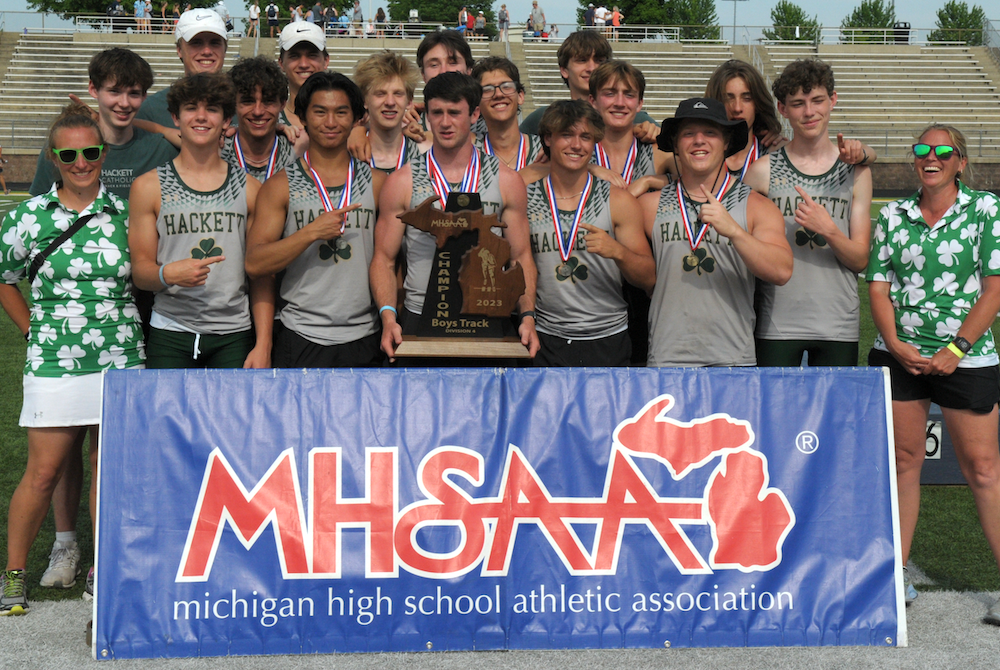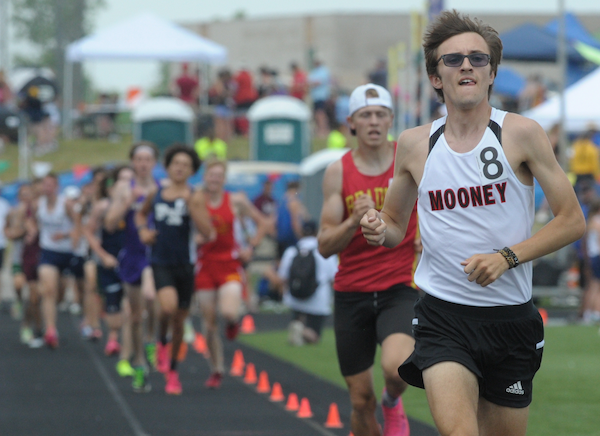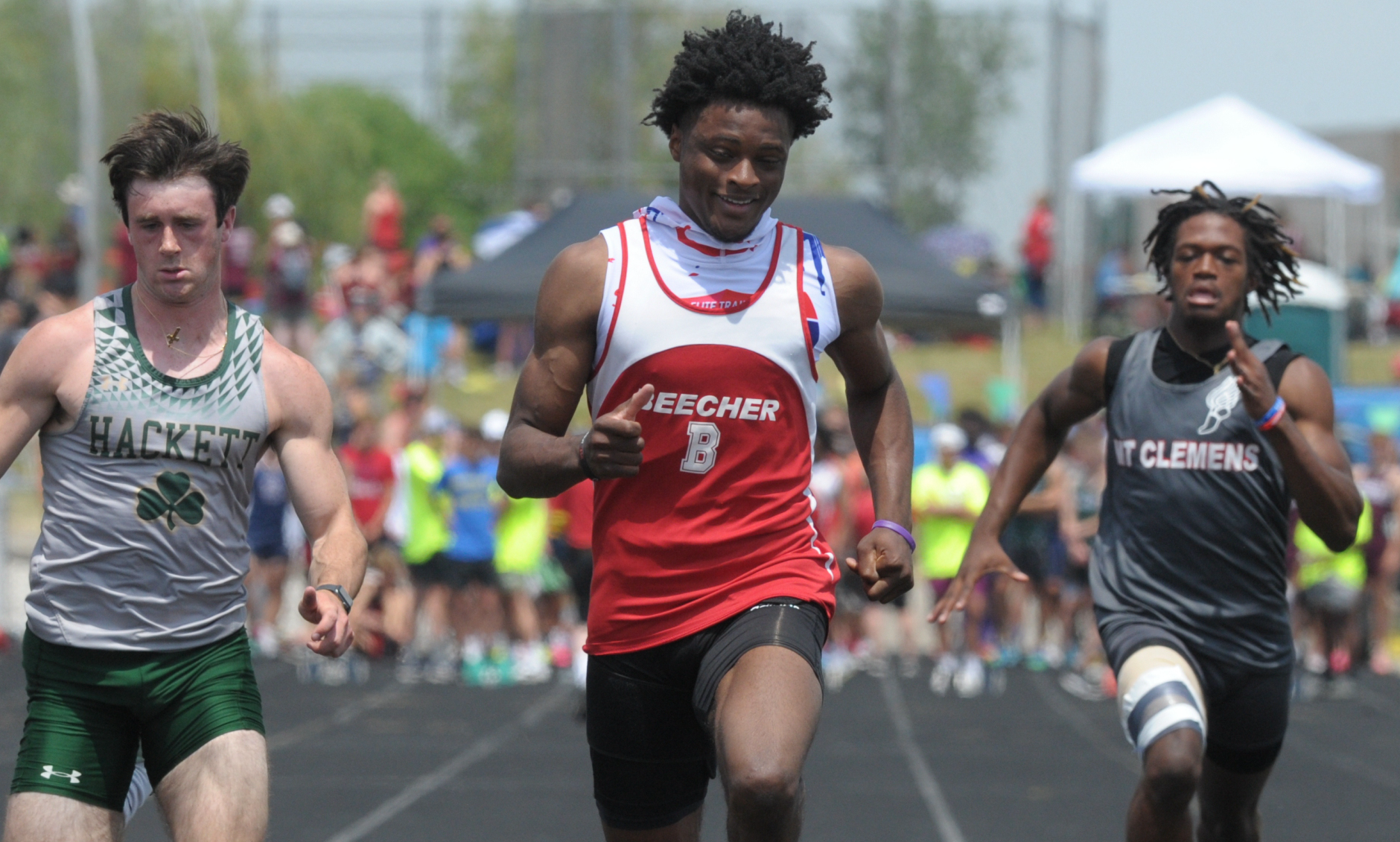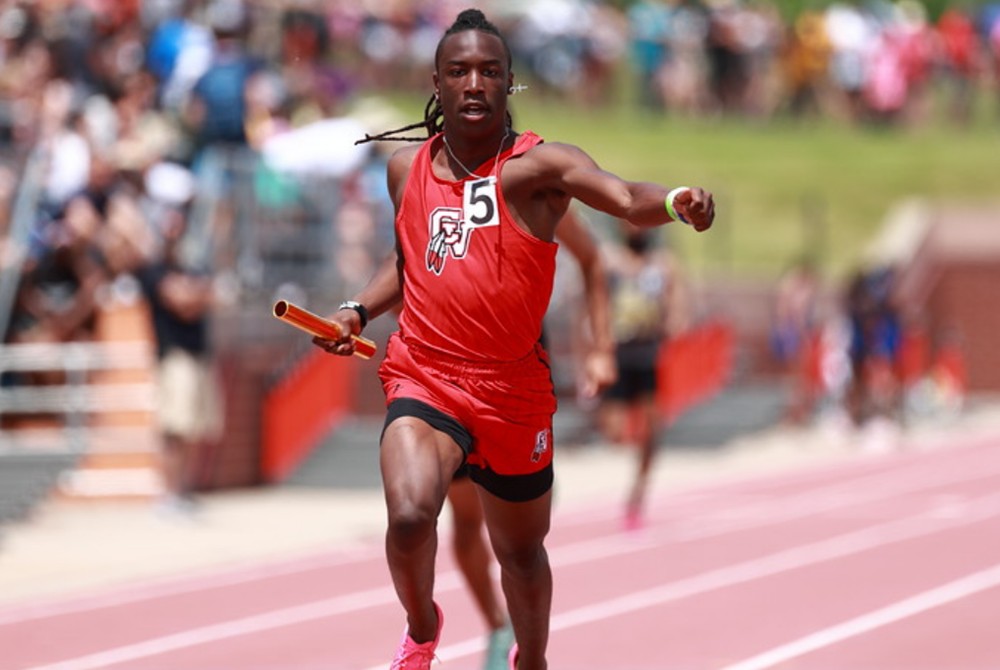
Thrower Claims Lone Individual Title to Lead Hackett to Team 3-Peat
By
Tom Lang
Special for MHSAA.com
June 3, 2023
Kalamazoo Hackett Catholic Prep just keeps winning and winning.
This time the Irish took home their fourth title in the last five Lower Peninsula Division 4 Track & Field Finals, on Saturday at Hudsonville.
Hackett’s only individual title was taken by discus winner Nathan Buchmann, a senior, who was fine knowing he was the shortest in stature among all the sizable competitors.
“In the offseason after football I worked out every day, working towards this goal,” he said after getting his medal. “I would say this takes 80 percent technique and 20 percent strength to throw the discus. So, length can help but if you have good technique and are really strong, that will play into it.
“I think we are very balanced throughout the meet today,” he said about teammates that scored points in finishes other than first place. “We have 13 guys here today, and we have people in a lot of the races. But I do not run; I have too short of legs to be a fast runner,” he said with a chuckle.
Buchmann had to work through a hip injury to compete this spring.
“I think the setbacks are what make you strong,” he said. “You can either give up through the setbacks or push forward and become better.”
 Coach Charissa Dean agreed.
Coach Charissa Dean agreed.
“The kids have big hearts,” she said after all the points were totaled and the Irish were on top once again, with 53. “They worked hard. They had a lot of potential when we started the season. And we had a lot of drive to put in the work, and we are happy the results came out the way they did.”
Reading was runner-up at 47 points, followed by Wyoming Potter’s House Christian with 42, then Fowler and Flint Beecher each with 37 points.
Senior Lezawe “Moses” Osterink, of Potter’s House Christian, placed second in 1,600 but took the 3,200 title as defending champ of both. He dominated the latter by lapping the field with a final lap kick that resembled more of a superhero speedster.
“Nobody really took it out that hard at the start,” he said. “There was a freshman (Marek Butkiewicz of Hackett) that tried to get the pace going quick, but me and Dakota (Dykhuis of Montabella) just kind of sat back and gradually pulled him through.
“We took it gradually, and I was just relying that I could kick.”
Kick did he ever. The trio were neck and neck the majority of the race in a grouping ahead of the pack.
“With 400 to go I just tried to go all out,” Osterink said. “I had a lot more left than I thought and I was pleased with the win. Not really the time, but that doesn’t matter, especially this hot out.”
The overall meet was in the low 90s/high 80s heat and searing sun all day. So, race officials allowed the unique opportunity for coaches to spray the runners with water and give them water bottles.
“It was very weird because I’ve never taken water to drink while I’m running, so I didn’t know how that would feel,” Osterink said. “And they were spraying us and hitting us in the face. It was kind of fun.”
Junior Tyler Lenn of Marine City Cardinal Mooney defeated Osterink at his own game in the 1,600.
“I’m feeling great,” Lenn said after grabbing the medal. “I said to a newspaper after one of my races (during the season) I was right where I wanted to be. This has been a long rebuilding process for me since an injury back in the fall, and I set a pretty high goal the day the injury happened. I was telling myself I needed to fulfill what I said I would do at the beginning of last cross country season. And that is what I did today.”
Lenn suffered an ankle sprain from a misstep that turned worse because he kept running through the season on it.
“Coming back from that was pretty tough, but I wouldn’t have it any other way,” he said.  “Perseverance; I said from the beginning what I was going to do. I kept my eye on that target, and no matter the circumstances life threw at me, that I was going to make it happen and I am a man of my word.”
“Perseverance; I said from the beginning what I was going to do. I kept my eye on that target, and no matter the circumstances life threw at me, that I was going to make it happen and I am a man of my word.”
Jaylin Townsend, a senior from Flint Beecher, dominated the short races. He won the 100 dash (10.67) and 200 dash at 22 seconds flat. It was his third 100 win at a Finals.
“I put in a lot of work; I had to three-peat,” he said after the 100. “There’s a lot of great competition here, so I knew I had to come out and run my best.”
Concord in the 400 (43.72), Buckley in the 800 (1:30.76) and 1,600 (3:29.13) and Potter’s House in the 3,200 (8:14.18) were relay champs Saturday. Reading’s Tayshawn Bester won the 110 hurdles (15.13), and Athens’ Landen Bennett won the 300 (39.85). Caseville’s Nathan Feltner won the 400 (50.76), and Vestaburg’s Owen Patton claimed the 800 (1:55.11).
Fruitport Calvary Christian’s Bradley Richards won the high jump (6-10), and Peck’s Alex Affer won the long jump (23-4). McBain Northern Michigan Christian’s Isaac Bowden was first in pole vault (13-0), and Brown City’s Kyle Affer won shot put (49-2).
PHOTOS (Top) Kalamazoo Hackett Catholic Prep celebrates its third-straight LPD4 title Saturday. (Middle) Cardinal Mooney's Tyler Lenn, far right, sets the pace in the 1,600. (Below) Flint Beecher's Jaylin Townsend, middle, crosses the finish first for one of his two sprint championships. (Photos by Ken Swart/RunMichigan.com.)

Chippewa Valley's Heard Has Big Plans to Add to All-Time Sprint Legacy
By
Keith Dunlap
Special for MHSAA.com
May 10, 2024
CLINTON TOWNSHIP — Clinton Township Chippewa Valley senior Shamar Heard admits he’s thought about it, and for good reason.
 After all, why not at least entertain the thought of doing something unprecedented in state history when it comes to track & field?
After all, why not at least entertain the thought of doing something unprecedented in state history when it comes to track & field?
Two years ago as a sophomore, Heard achieved the double in the fastest races, winning both the 100 and 200-meter dashes at the Lower Peninsula Division 1 Finals.
Last year, Heard completed the trifecta when it came to sprint state titles, focusing solely on the 400 dash and winning that event in 47.78 seconds while also running on first and third-place relays.
So, how about trying to train for and win all three events this year as a senior? Who in the state would be able to stop him?
“I definitely have been thinking about it,” Heard said. “Because why not? It probably hasn’t been done in a long time, if ever.”
But while the thought has crossed his mind, it won’t happen. It’s a little much on the body — in particular running the 100-meter dash — to try and do all three at once.
However, Heard in the coming weeks is still in a good position to cement what already is a place among the greatest sprinters to come through the state of Michigan.
First, he has big things in mind for his specialty race, the 400 meters. He has won two consecutive AAU national titles in that event in addition to the Finals title he won last year, but is craving more.
“I want to be at 45 seconds for the state meet,” Heard said noting the June 1 Finals at East Kentwood.
In addition, Heard plans on competing in the 200 meters at East Kentwood. He also is a part of Chippewa Valley’s 800 relay team that won last year in 1:26.41. He’s expected to qualify for all three at the Regional on May 17 at Romeo.
 When Heard is done with high school, he will continue running track at Tennessee.
When Heard is done with high school, he will continue running track at Tennessee.
It’s all mighty impressive for a speedster that Chippewa Valley head coach Terry Wilson said hates lifting weights and is “barely above 150 pounds.”
“He doesn’t weigh a whole lot, but he generates a lot of power,” Wilson said. “His strength-to-weight ratio has to be astronomical. He’s just gotten better with his form.”
Throughout his entire life, Heard said he’s simply loved racing. When he was a kid, he would constantly pick out a stop sign on a street or another spot in a yard and race others to the finish, often beating them with ease.
When he was 10 years old, he was invited by a friend to come out for a track team, and he proceeded to beat others in races continuously.
As he got a little older, Heard discovered how gifted he was running the 400 meters and started to focus more on that event.
Heard said he loves the 400 meters so much mostly because he loves embracing a challenge many sprinters don’t want to face.
“I like that not many people want to go through that pain,” he said. “I take it as a compliment when people look at (the 400) and they say, ‘Hey, people are crazy for doing that.’ That makes me motivated to do it.”
Wilson admits there doesn’t have to be much coaching done with Heard. It’s just simply a matter of getting together before races to discuss how he feels and what his body can do that day.
“He understands his body a little bit better every year,” Wilson said. “He understands what he needs to get done in races. He’ll run the 200 in practice and I’ll have a stopwatch on him, and he’ll say, ‘That felt like a 24 (seconds). I look at my stopwatch and it’s a 24.2. He has that ability to gauge how fast he’s going. It’s just different with him.”
Heard also was a football player at Chippewa Valley, but gave the sport up before last fall to focus solely on his track career.
“I was just looking at the bigger picture,” Heard said. “I was more consistent in one sport than I was the other.”
He will run the 400 meters at Tennessee, and then the sky could be the limit given what he’s accomplished already on a national level.
Until then though, Heard will spend the rest of his high school career trying to win more hardware and leave a mark that might be impossible for future sprinters in Michigan to surpass.
“I want to give everyone a senior year that they will remember,” Heard said. “I want to go out with one of the most memorable years of a high school athlete.”
 Keith Dunlap has served in Detroit-area sports media for more than two decades, including as a sportswriter at the Oakland Press from 2001-16 primarily covering high school sports but also college and professional teams. His bylines also have appeared in USA Today, the Washington Post, the Detroit Free Press, the Houston Chronicle and the Boston Globe. He served as the administrator for the Oakland Activities Association’s website from 2017-2020. Contact him at [email protected] with story ideas for Oakland, Macomb and Wayne counties.
Keith Dunlap has served in Detroit-area sports media for more than two decades, including as a sportswriter at the Oakland Press from 2001-16 primarily covering high school sports but also college and professional teams. His bylines also have appeared in USA Today, the Washington Post, the Detroit Free Press, the Houston Chronicle and the Boston Globe. He served as the administrator for the Oakland Activities Association’s website from 2017-2020. Contact him at [email protected] with story ideas for Oakland, Macomb and Wayne counties.
PHOTOS (Top) Chippewa Valley’s Shamar Heard crosses the finish line while anchoring the winning 800 relay at last year’s LPD1 Finals. (Middle) Heard prepares to run the winning 400 at last season’s championship meet. (Click for more from Jamie McNinch/RunMichigan.com.)

